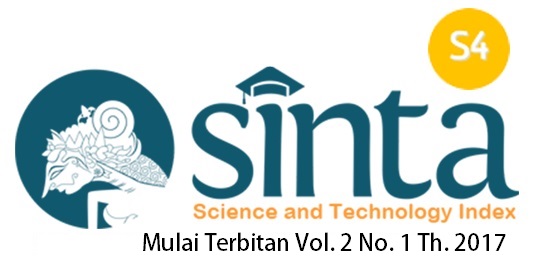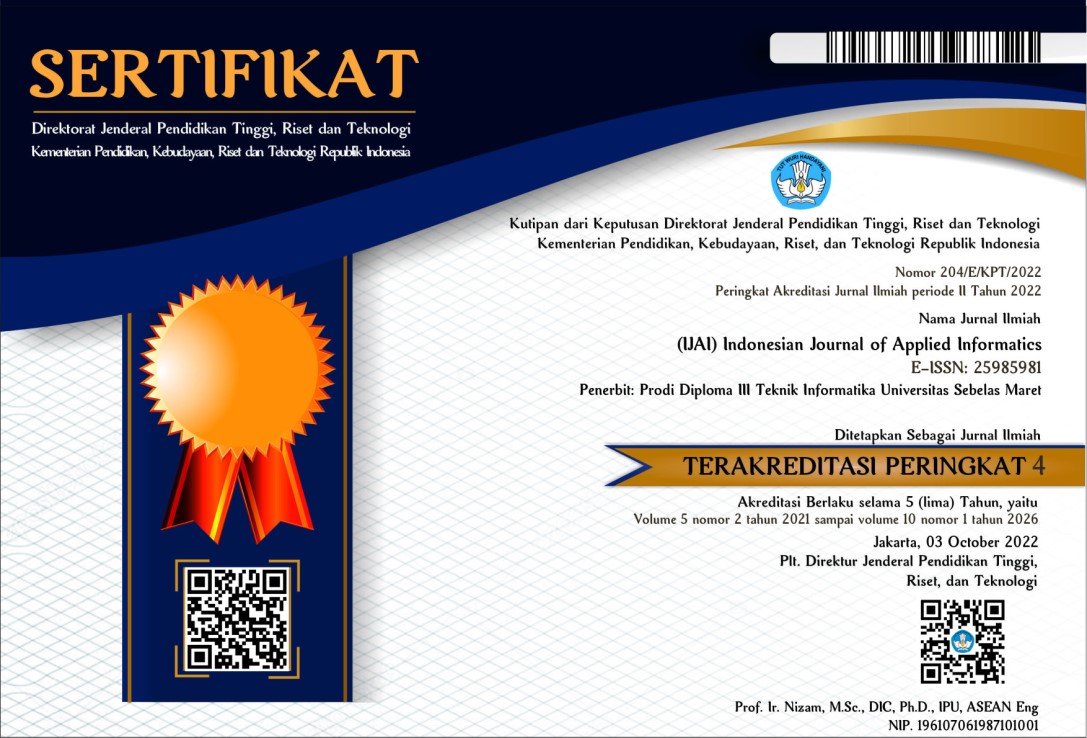Rancang Bangun Sistem Informasi Presensi Perkuliahan Dengan QR-Code di D3 Teknik Informatika Universitas Sebelas Maret
Abstract
Abstrak
Dengan berkembang pesatnya teknologi seperti saat ini, kita dituntut untuk bergerak cepat dan efisien. Salah satu caranya adalah dengan memanfaatkan teknologi yang ada dengan baik. Presensi yang menjadi bukti kehadiran mahasiswa dalam suatu perkuliahan haruslah dilakukan secara efisien. Oleh karena itu, dibutuhkan penggunaan teknologi, dalam hal ini perangkat lunak, agar bisa menjadikan presensi kehadiran menjadi efisien dan reliabel. Tujuan dari penelitian ini adalah untuk membuat perangkat lunak yang mampu memberikan kemudahan bagi dosen dan mahasiswa dalam mengisi daftar kehadiran dalam suatu perkuliahan dimana metode yang digunakan dalam penelitian ini adalah System Development Life Cycle. Fitur dalam sistem ini antara lain halaman web untuk admin dan dosen, memanajeman logbook, serta membuat aplikasi android untuk mahasiswa melakukan scan QR code. Hasil dari sistem informasi presensi perkuliahan ini adalah sebuah sistem presensi yang mampu meningkatkan efisiensi dalam proses presensi perkuliahan, dengan fitur antara lain, mampu memindai kode QR yang dibuat dalam setiap perkuliahan untuk presensi mahasiswa, membuat logbook perkuliahan, merekap logbook dan presensi mahasiswa.
Abstract
With the rapid development of technology today, we are required to move quickly and efficiently. One way to do this is by making good use of the available technology. Attendance, which is proof of a student's presence in a lecture, must be done efficiently. Therefore, the use of technology, in this case software, is needed to make attendance recording efficient and reliable for both lecturers and students. The purpose of this research is to create software that can provide convenience for lecturers and students in recording attendance in a lecture, using the System Development Life Cycle method. The features in this system include a web page for admin and lecturers, logbook management, and creating an Android application for students to scan QR codes. The result of this lecture attendance information system is a presence system that is capable of improving efficiency in the lecture attendance process, with features such as the ability to scan the QR code created for each lecture to record student attendance, create a lecture logbook, and record student logbooks and attendance.
Keywords
Full Text:
PDFReferences
[1] S. Tiwari, "An Introduction to QR Code Technology," 2016 International Conference on Information Technology (ICIT), Bhubaneswar, India, pp. 39-44, 2016. doi: 10.1109/ICIT.2016.021.
[2] D. Puput, M. Putri, and H. Supriyono, “Rancang Bangun Sistem Presensi Berbasis QR Code Menggunakan Framework Codeigniter (Studi Kasus Kehadiran Asisten Praktikum) Development of QR Code-based Presence System Using Codeigniter Framework (Pratical Assistant’s Attendance Case Study),” J. insypro, vol. 4, no. 1, pp. 1–9, 2019.
[3] M. Al Satrio, L. A. Abdillah, and A. Syazili, “Aplikasi Presensi Mahasiswa dengan Menggunakan QR Code Berbasis Android pada Universitas Bina Darma”. Seminar Hasil Penelitian Ilmu Komputer ke-2, pp. 7–12, 2017. doi: 10.17605/OSF.IO/NMHRX.
[4] A. Priyambodo, K. Usman, and L. Novamizanti, “Implementation of Android-Based Qr Code in the Presence System,” Jurnal Teknologi Informasi dan Ilmu Komputer, vol. 7, no. 5, pp. 1011–1020, 2020. doi: 10.25126/jtiik.202072337.
[5] A. H. Setyawan, K. I. Satoto, and R. R. Isnanto, "Perancangan Aplikasi Sistem Presensi Mahasiswa Menggunakan QR Code pada Sistem Operasi Android," Transient: Jurnal Ilmiah Teknik Elektro, vol. 2, no. 2, pp. 241-246, 2013.
[6] A. M. Dima and M. A. Maassen, “From waterfall to Agile software: Development models in the IT sector, 2006 to 2018. impacts on company management”. Journal of International Studies, vol. 11, no. 2, pp. 315–326, 2018. doi: 10.14254/2071-8330.2018/11-2/21.
[7] Q. Li and Y.-L. Chen, “Entity-Relationship Diagram,” Modeling and Analysis of Enterprise and Information Systems, pp. 125–139, 2009. doi: https://doi.org/10.1007/978-3-540-89556-5_6.
Refbacks
- There are currently no refbacks.






